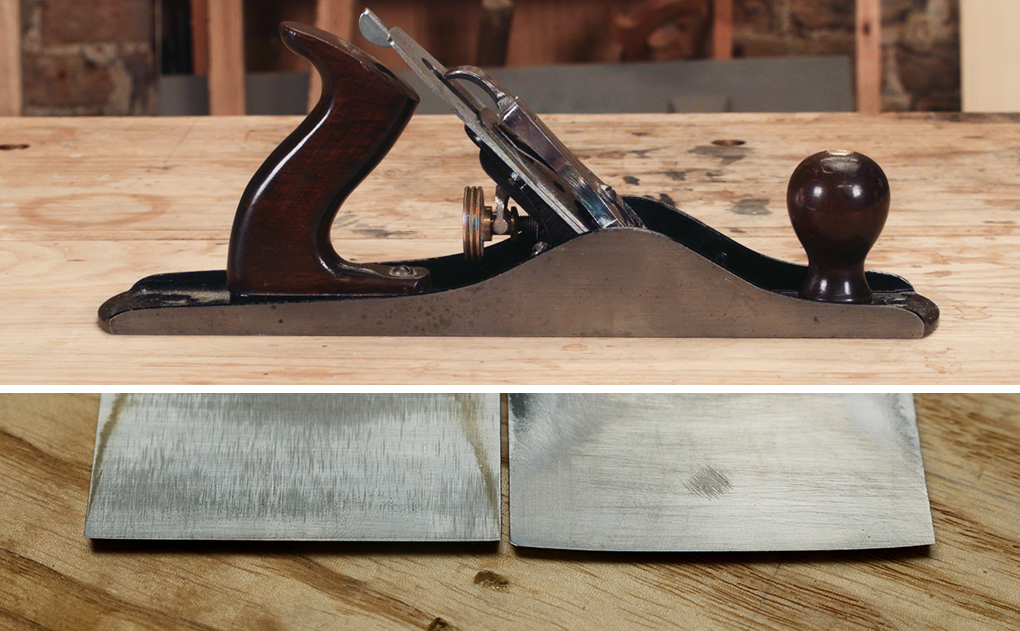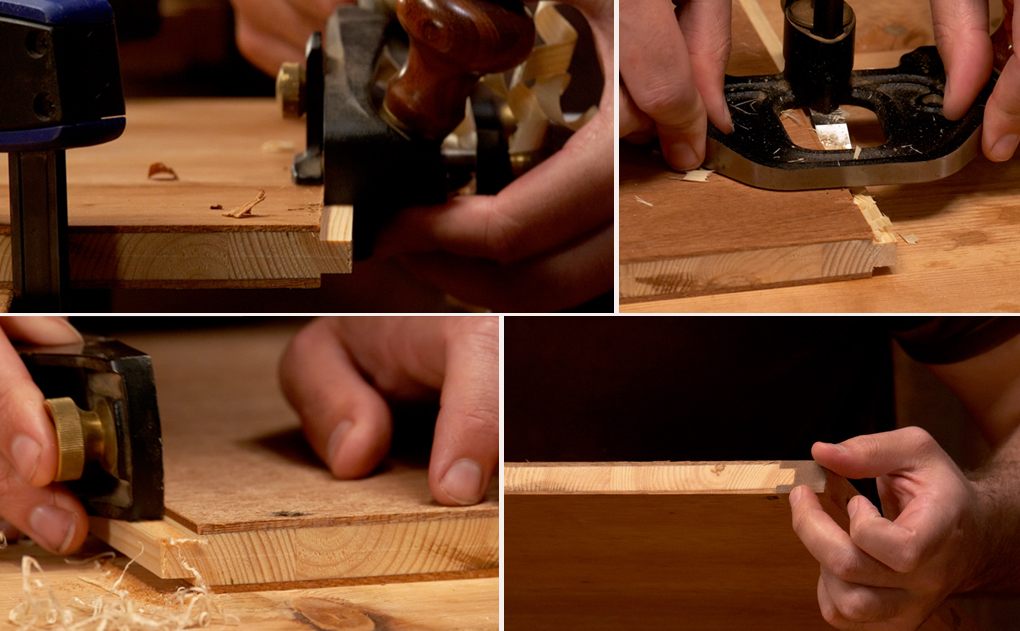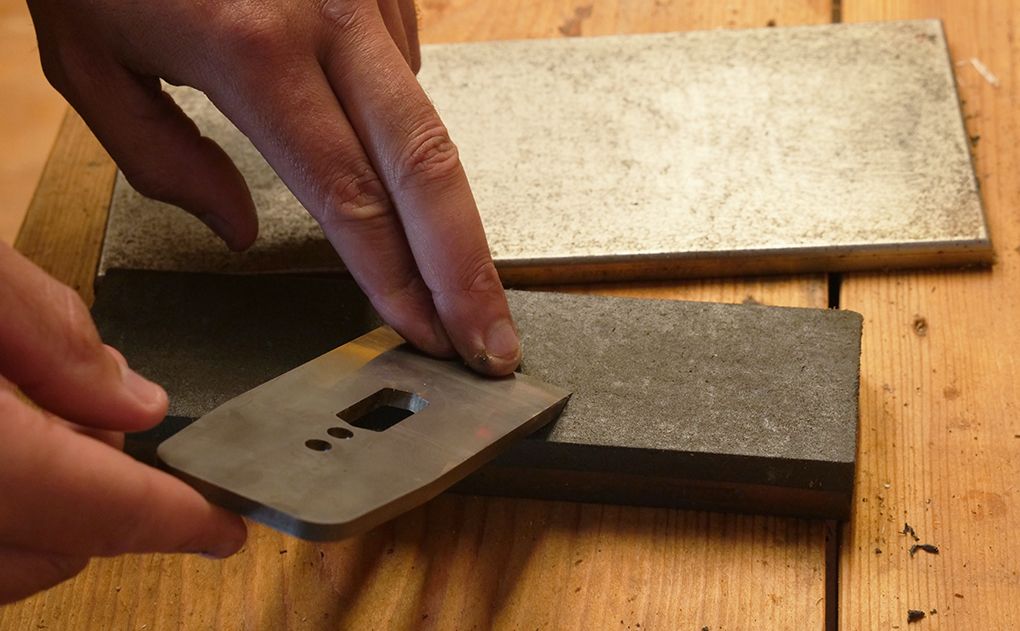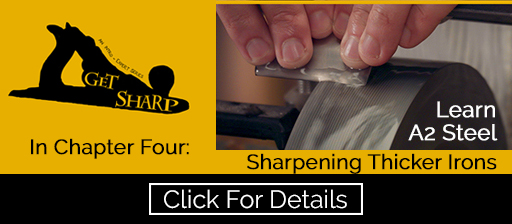To become efficient in anything I find it’s much better to specialise rather than use one size fits all.
So how can a minimal hand tool kit become anything other than a set up for getting you started?
The answer is in understanding your cutting edge. We can use various cutting angles and shapes to optimise for specific jobs, and when it comes to hand planes the iron camber plays a huge role.
Cambers are the key to turning one hand plane in to a complete set up.

Specialising With A Minimal Kit
You could have every type of hand plane for every type of job but if you don’t understand your cutting edge they may as well all be the same tool. Altering the cutting edge however gives you tremendous control and an ability to set up just one plane for any job. Your hand plane can take on the role of scrub, fore, jointer, smoother and everything in between once you understand that cutting edge. Cambers, or a curved edge play a huge part in this.
The Importance Of Sharpening
Obviously learning to sharpen your irons is essential, don’t underestimate this.
An expensive hand plane will be useless if it’s blunt, so if you can’t get a sharp edge, work on that first.
But to turn that one plane in to ‘specialist’ tool you need to think beyond simply sharpening and start to understand exactly what you’re asking the iron to do.

Sharpening a cambered iron. The key to working efficiently with hand tools starts with mastering edge sharpening. Check out the Get Sharp series for a comprehensive video guide covering everything from setting up with sharpening stones, to the optimum routine & methods, and understanding cutting angles & cambers.
Iron Cambers – Different Curves, Different Jobs.
The edge of a plane iron is rarely straight.
Even for taking smoothing shavings you’ll want to nick the corners off to prevent tracks in your work.
A larger curve is used to help us take thicker shavings. The more curve, the heavier the shaving.
These curves are known as cambers, and this can be a confusing area for anyone new to hand tool woodworking.
The good news is creating a camber is simple.
Don’t faff trying to get perfect symmetry or even a smooth curve.
But do be mindful that one of the biggest problems I see people having with cambers is they’re using a curve that’s just too big.

Subtle difference in a camber can make a huge difference to the shaving.
Why Camber Your Irons?
For heavy material removal we want to rip away as much timber as quickly as possible.
But this shouldn’t simply be a race or test of power.
Optimising an edge means sacrificing the stuff that we don’t need.
When removing material this often means forgetting about the surface quality.
Clever hand thicknessing is all about lowering resistance. A hand plane that’s properly set for thicknessing will make it easier to remove thick shavings, than it is to remove wafer thin ones with a smoothing set up.
Lowering resistance when hand planing:
- Sharpen the iron at a lower angle to ease cutting (although a steeper angle may be required if you’ve got to plane through some tough stuff).
- Keep a wide mouth and retracted cap iron to allow shavings to clear without friction.
- Be sure to wax up the sole.
- And most importantly, set up with the right camber.
You need to think of it like this, the purpose of cambers is to make our life easier.
Cambers are great when it comes to heavy shavings because they make the impact progressive when the plane engages with the wood.
At first its just the front of the iron that digs in, then gradually more and more of that cutting edge will get to work as we push.
This is hugely important, because there’s so much impact at the start of a deep cut that without the camber everything’s going to buckle, yourself included.
Of course technique is also important, and the aim is to take as few shavings as possible rather than hogging off wood in a random manner. This is particularly true when using a hand plane to flatten your boards.
The Problem With Big Cambers.
An iron is held in to a plane at an angle, so the amount of camber is directly related to the type of shaving that can be taken.
A large curve will make life difficult in one of two ways:
– You’ll take skinny shavings down the centre of the blade and have to take many, many more shavings than necessary.
– Or you’ll set for a full width shaving, and the depth of cut will be extreme, you’ll be burnt out after one pass.
The optimum camber gives us a manageable depth whilst producing a shaving that’s close but not quite the full width of the iron.
(We don’t aim at full width because the curve increases the length of the cutting edge, so full width would make a lot of resistance.)

Setting For An Optimum Depth Of Cut.
That manageable depth of cut depends on your circumstance.
If you’re inexperienced than start small and work upwards.
Softwood will allow a greater depth of cut than hardwood, and be mindful not to over do it if you’re got a marathon planing session ahead.
Remember, the camber is there to help us remove material faster, not wear us out, so match the resistance of each stroke to the workload.
Thin & Soft Plane Irons For A Progressive Camber.
All of this means there’s no perfect camber or set of cambers you can prepare.
A tiny variation in the curve makes a large difference to the shaving, and your depth of cut is pretty much dictated by that edge.
This is why I’ll only use thin irons made from softer steel for anything other than smoothing jobs. (And why I have a dislike for sharpening thick plane blades made from modern steels.)
The thin softer irons work quickly at the sharpening stones, and provide the ability for what I call a ‘progressive’ sharpening habit. Your cutting edge can be altered on the fly, optimising for every task.
This rapid alteration also becomes a great learning tool, quickly giving you a feel for how the different levels of camber respond.
It’s worth noting that if you have a bevel up plane, then you’re dealing with a different animal. The irons are not only thick, but require a more dramatic camber for the same effect.
Personally I don’t see a place for bevel up planes when it comes to anything heavier than smoothing shavings – you’ll find more on that when I discussed my thoughts on my Veritas bevel up plane.
Two Irons, One Hand Plane.
There’s no reason to stick with the one plane set up, but if you do then all needs can be covered by using two irons.
With the first iron I can adjust the camber to take anything from super fine to medium shavings.
The second will go from a medium camber through to coarse.
And I can change either of the irons to either of their extremes in just one sharpen if needed.
I’m not going to provide radiuses to work to. If you want to become fluent at hand planing then forget the numbers and start having a play.
If you’re looking to set up a tool kit then you’ll want to spend wisely, ensuring that you have quality where you need it but no excess. It’s probably much more simple than you think, and we have it all covered in our guide to the complete (yet minimal) hand tools for woodworking.

![How do I Sharpen a Router Plane? [Q & A Video]](https://www.theenglishwoodworker.com/wp-content/uploads/2022/11/how-to-sharpen-a-router-plane-video.jpg)
![Bench Top Edge Jointing [with Video]](https://www.theenglishwoodworker.com/wp-content/uploads/2022/10/bench-top-edge-jointing-video.jpg)



Once again your articles timing seems impeccable as my Atoma diamond plate arrived today to cosy up nicely with the oil stone and strop, my thin Stanley irons are ready to be treated to the Maguire Method™.
Workbench build starts next weekend when I get home, I had to pick up some extra material for the aprons and legs today. The Spring Bank Holiday is looking like a busy one.
I guess a thorough rewatch of both the English Workbench and Get Sharp series are in order to prepare for when I am back home.
Sounds like you’re well prepared! Best of luck with your build, and may the Maguire Sharpening Method TM serve you well!
You’ll probably have your bench built quicker than the time it takes to watch the Series.
Hi Darryl!
I’m “getting there”. The aprons are almost done – problem is I can only do that stuff once the kids are in bed (and I get up really early). Still, I enjoy it! The “Get Sharp” series was really invaluable for getting started…
I also need to pick up material for the bearers tomorrow night, and I hope I can dry fit the aprons then as well, after cutting the angled notch for the legs – then we will see how well stuff fits together.
Richard,
What is your view on the LV Scrub Plane? I’ve been thinking for a while now of changing the radius. It just seems way too aggressive. It’s great for hogging off 1/8″ from areas of a board, but hard to use to make the first pass on an entire face. Or maybe I should just set up a #5 for that with a milder camber?
Hi Gary,
I’ve got the Lie Nielsen scrub, and I do love them for the right job.
The initial stages of prepping as a general rule is not a scrub plane job. I only use a scrub plane if I’ve got heavy thicknessing to do.
I recommend if you’re just skimming up rough boards to try a cambered No. 5. A strong 1/16″ cambering off to each corner would probably be a good place to start.
I think that these scrubs are far to agressive to be used for surface prepping – reserve them for heavy material removal.
Great remarks, Richard. These words are especially important for those getting started with hand tools. I’m fortunate to have got my grandfather’s Stanley No.40 scrub plane. While it’s a masterful workhorse when surfacing or thicknessing rough stock, a second iron in a No.4 or No.5 will be more appropriate for many tasks. Listen to Richard here. His remarks about camber and iron thickness are important.
Hi Richard, are you familiar with the german irons from ulmia or ECE? Are they suitable dir “progressive cambers”? Or are they too thick? Or the wrong steel?
Cheers
Gunter, I have a ECE smoothing plane that must be 20 years old. As I am sure you already know the blade is really thick but of great quality. I use it for all my smoothing. In fact it is the last plane that touches my wood.
I think those blades would be fine and I use Richard Get Sharp system exclusive for my wood working blades, chisels, etc..
I absolutely love the ECE planes, and whilst the irons are thick (no thicker than any wooden plane really) they are soft.
Whilst nothing is easier to sharpen than a Stanley iron, these things are more than workable. If you plan to change your cambers regularly then I’d make sure that your primary bevel is shallower than normal, as this will allow you to change the edge mid job with less steel to remove.
Great advise as usual. If anyone hasn’t got the ‘Get Sharp’ series yet, then you just must. It really is brilliant. This will probably sound like a sales pitch or the gushing praise of a beginner, but I screwed up one A2 iron and three(!!!) expensive diamond stones before getting the series and learning the Maguire Method©®. What a revelation, not least the fact that the whole sharpening setup is straightforward and affordable. Finally cambers and angles make sense and when sharpening I now know what I’m doing, but more importantly, why. Sharpening is (almost) enjoyable and, a huge surprise to me, easy. It still amazes me what an enormous difference a tiny change in camber or angle can make. Just one query, Richard: in bevel up planes, is there any disadvantage to replace the A2 irons with the O1 steel?
Hi Henrik,
Many thanks, I appreciate the kind words, and it’s great that it’s been helpful.
Even with O1, these bevel up irons are so thick, that I’d treat them as if they were A2. Even with the coarsest diamond stone in the world, trying to hand crank a primary bevel on it could take you all weekend. However I would find that you’d have slight benefits with O1 when it comes to very low angled work. A2 hates low angles as it’s too brittle and chips. Nothing shoots end grain like O1.
Richard,
The arc on the iron you had a stone that had a arc already in the stone to get the arc that was needed. What was the name of the stone,company, .
thanks Ralph
I think I need a shoulder plane to help me flatten down my lap joints.
Im struggling to get them flat with chisels alone.
Any suggestions on a shoulder plane? There’s lots a variety and it’s confusing and intimidating – maybe that would make a good blog post.
hi Richard. I like to make canoe paddles and primarily use a spike shave. Do you recommend cambered irons for this application?
Sorry, “spokeshave”